PAGE 1
Since 1999, there have been numerous sculptors who have participated in the Sculpture in the South Show and Sale. We consider these sculptors to be lifetime partners in the growing Summerville Permenant Public Sculpture and Extended Collections. We are grateful for their support and participation.
Sculptors are listed in alphabetical order. Click on a name to view that sculptor's biography.
PAGE 2
James Ford
Barbara Frets Simmons
Chris Gabriel
Martin Gates
J. Gail Geer
Bobbe Gentry
Jim Green
James Goshorn
Jeff Gottfried
Lou Greiner
Gary Grossman
Hap Hagood
Alan Hamwi
Heiner Hertling
Jack Hill
James Hixson
Gary Hughes
Leslie Hutto
Lorann Jacobs
Jane Jaskevich
Gregory Johnson
Ott Jones
Karryl
Dorothy Kennedy
Mariah Kirby-Smith
Julia T. Knight
William Kolok
Matt Lewis
Mitch Lewis
PAGE 3
VanKeuren Marshall
Roger Martin
Andi Mascareñas
Diane Mason
Marie-Christine Maitre de Tarragon
Carl McClesky & Betsy Scott
Julie McCraney-Brogden
Shirley McWhorter-Moss
Judy Mooney
Michele Moushey Dale
Ken Newman
George Nock
Nnamdi Okonkwo
Vala Ola
James Oleson Jr.
Gert Olsen
Alex Palkovich
James Paulsen
Scott Penegar
William Piller
David Pollard
Jo Pratt
Gary Lee Price
W. Stanley Proctor
Jane Rankin
Don Ray
Diana Reuter Twining
Paul Rhymer
Maureen Riley
Robert Rohrbacker
Patricia Romero
PAGE 4
Royal Richardson Miree
Karla Runquist
Nick Ryan
Kenneth Ryden
Wayne Salge
Wendy Salin
Stefan Savides
Valerie Schafer
John Sewell
Scott Shaffer
Kim Shaklee
Ken Smith
Roger Smith
Stephen Spears
David Springer
Mary Tanner
Richard Thompson
John Tolmay
Kate VanNoorden
Ronny Walker
Garland Weeks
Allen Weidhaas
Dale Weiler
Andrea Wilkinson
Adrianne Winer
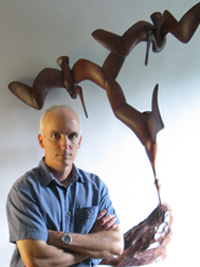
Van Keuren Marshall
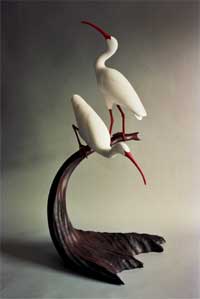
This South Carolina native is a "quiet" artist.
The vast majority of Summerville residents would not know the name of
the person in their midst who won the
"Best in World, Interpretive Wood Sculpture" in the 1990 Ward
Foundation Carving Competition. Or that his winning entry was purchased
for the Ward Foundation Museum's permanent collection. They're more likely
to know that he volunteers as a cabinetmaker for Habitat for Humanity.
This is not a "strut-your-stuff" artist, but one who is quietly
devoted to his family, his church, and his community. His talent, however,
has been hard to hide.
He has had a lifelong interest in wildlife - birds especially. As he
was growing up, that interest was often expressed through art. With his
fascination with the natural world, it was no surprise that he obtained
a degree in Biology from the University of South Carolina. His decision
to work in Alaska after college, coupled with exposure to artisans in
the woodworking field, ignited an underlying talent that few possess,
and provided him with a creative expression for his unique abilities.
He didn't begin carving birds until 1980, and within a few years became recognized nationally for his artistic creations. In 1986, his "Nonpareil-Painted Bunting" was chosen by the Leigh Yawkey Woodson Art Museum for their touring exhibition, featured in museums in Seattle, Santa Barbara, Honolulu, and Beijing, China. The following year the Leigh Yawkey Woodson Art Museum purchased his "Pelican Plunge" for their permanent collection. In 1990, The Gibbes Museum of Art presented his works in a solo exhibition: "Winged Sculpture - The Artist and His Style". His style now ranges from very realistic decorative, to a less detailed, interpretive form. Marshall's desire as an artist is to create compelling works with the marvelous elements of form, design, and color that God offers us in His grand creation.
(Sculpture title: White Ibises)
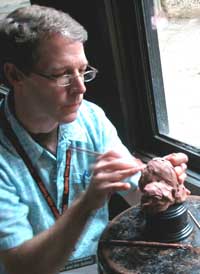
Roger Martin
Martin has been creating wildlife sculpture in various mediums for more than 35 years. Starting his career as an assistant curator of exhibits at the Schiele Museum of Natural History. Roger has traveled the world, studying animals in the wild, from the goats and sheep of Alaska to the birds and mammals of Africa, Asia and the South Pacific.
Having an in-depth knowledge of anatomy gives Martin the ability to instill power and agility into a subject as well as a glimpse into their spirit.
Roger Martin was an active participant in previous Sculpture in the South's Show & Sales and graciously held live sculpting demonstrations during those events that many show attendees enjoyed and remember still today.
Martin is a lifetime resident of North Carolina and continues to express his artistic visions through his sculptures.
Roger Martin sculptures in our B.I.R.D.S. collection:
Mourning Dove (below, #13 in our BIRDS brochure)
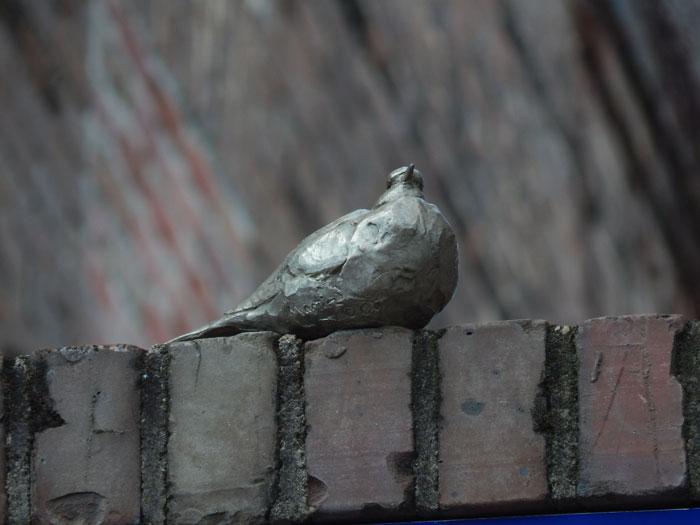
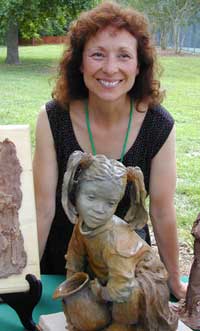
Andi Mascareñas
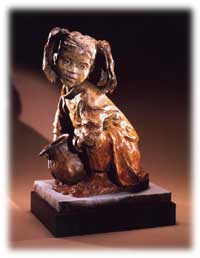
Andi Mascareñas graduated from Rocky Mountain College of Art & Design in 1984 with an illustration degree but soon left illustration to pursue three-dimensional work. Whether ballet or other forms of dance, figurative movement is what has inspired Andi’s work over the years. In the beginning of her career, Andi explored other sculpture mediums such as stone but found the flexibility of clay adaptive to her ability to sculpt on location and create the impressionistic style in her work. She uses warm earth clays, which can be fired at high temperatures and then applies a metal application on the surface of her sculptures. She deliberately and directly applies chemicals over the surface, which creates her beautiful patinas.
Coming from a Latin background, Andi Mascareñas has surrounded herself with a culture that has taken her around the world exploring and immersing her in the tapestries of other countries. Joshua Cain, her son, has been an inspiration to her throughout her art career. Always inspiring her with stories of humor she has woven into her artwork. She sculpts on location wherever she can because “it connects me directly with my subject and where I can experience the richness of the culture of everyday life,” says Andi. She travels with her husband, Master oil painter, Kim English enjoying both sculpturing in clay when possible but also oil painting. Being a diverse artist, Andi’s oil paintings show the enjoyment she has in painting boats, landscapes, and harbors. However, painting the figure is always central in her work. “Painting on location is exhilarating for me. It gives me the ability to feel the energy of another culture in a different manner than sculpture. But I have found that painting gives energy to my sculpture and sculpting gives energy to my paintings, how I experience my world with form and color,” says Andi.”
Andi’s sculptures have been recognized by national art publications such as Southwest Art magazine and Sculpture Pursuit magazine. For the past 11 years, Andi has been invited to participate in the prestigious Sculpture in the Park Show in the Benson Sculpture Garden in Loveland Colorado one of the largest sculpture shows in the US. She has also been involved in numerous Gallery and group shows. Her artwork is collected throughout America and abroad.
(Sculpture title: Wash)
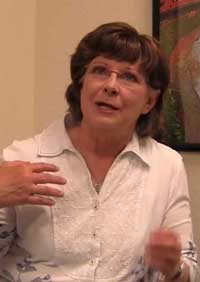
Diane Mason
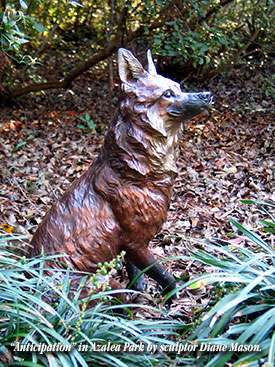
Strictly speaking, if you had to classify Diane Mason's sculpture, it would be called "animal sculpture." But that nomenclature is so far removed from what she creates, that it just isn't adequate. Her pieces exude personality. She invariably has people gathered around her, asking why - or how - she chose a particular animal, or the story behind its creation. After being stopped dead in my tracks to appreciate 'Swan Lake,' It Isn't - the Dance of the Blue-footed Booby," I learned that by educational degree, she is an "Ethologist" - one who studies animal behavior. And that clarified what transforms it into "art." Diane Mason doesn't merely master anatomical proficiency, but instills in her works the natural behaviors and personality of each animal, making each one interesting and unique. Her love for each animal is clear, and she makes the viewer more interested and appreciative of her subjects.
She began her artistic career in 1980, experimenting with the medium of scratchboard. She entered her first show in 1982 - and sold out! With that show judged by the curator of art at the Wichita Art Museum, she was selected for a one-woman show at the Museum's sales gallery a year later. Awards followed from the National Wildlife Art Show, and she was commissioned to create the First of State art print (of Sandhill Cranes) for the Kansas Audubon Society in 1985.
In 1992 she ventured into a new realm: sculpting. Taking workshops with nationally recognized sculptors such as Gerald Balciar and David Turner, she diverted her artistic efforts to sculpture, and moved to the foothills of Loveland, Colorado to immerse herself in that "sculptor's paradise." She loves the fact that her collectors are drawn to the "attitudes" of her subjects - and enjoy the fun imbued in them. A recent collector battling breast cancer and chemotherapy told Diane she HAD to have the "Blue-footed Booby" in her house, because it made her feel almost like dancing herself each time she looked at it. That's the power of art.
Diane Mason sculptures in our permanent collection:
Anticipation (above, #9 in our brochure)

Whisper on the Wind (above, #10 in our brochure)
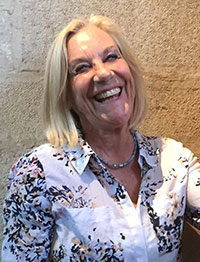
Marie-Christine Maitre de Tarragon
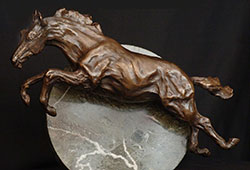
Marie-Christine Maitre de Tarragon was born in Burgundy, France. She grew up in the family chateau, surrounded by art and horses. Her great-grandfather, the Marquis de Valdahon, was a renowned eighteenth century painter. Her grandmother, the Countess Marie de Tarragon studied art under the master Redoute. Her uncle, Count Richard de Tarragon, was a sculptor in the Bugatti tradition. His mentor was the sculptor PomPon, whose work is in the Museum of Dijon.
When Marie-Christine moved to America, she trained and rode steeplechasers and raced quarter horses. She now trains reining horses in addition to creating beautiful equine sculptures and paintings.
Her life with her horses and her art is intertwined.
"Throughout history, no animal has surpassed the horse as an object of human passion. The first conquest of Alexander the Great was the untamable Bucephalus; Richard the Third cried ,"my kingdom for a horse"; Jeanne d'Arc's war horse was an emblem of her knighthood. Through the centuries, the horse has embodied the human search for a particular kind of ideal - nobility without pride, beauty without vanity, fidelity without covetousness.
"All my life, horses have been my constant companions. They taught me courage, compassion and patience and their attentive ears are tuned to my heart."
(Sculpture title: Heart of Gold)
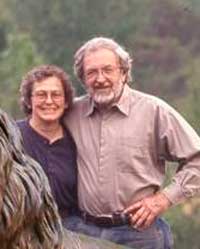
Carl McClesky & Betsy Scott
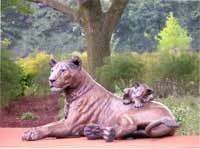
Carl McCleskey and Betsy Scott are a husband and wife sculpting team that focuses primarily on wildlife, but also enjoy the creation of figurative sculpture. They moved from Marietta, Georgia, to the relative wilderness of Lookout Mountain in 1984 in order to reestablish a connection with the natural world that had been an integral and indispensable part of their childhoods. They acquired a tract of land (a portion of which had been strip-mined and was in dire need of reclamation), and they set about restoring the land with the needs of wildlife foremost in their minds. With their own hands, they built ponds, planted thousands of trees, and built a house so secluded that they had to generate their own electricity for the first eight years. Their land now teems with wildlife (furred, feathered, and scaled) of every description, from bobcats to rattlesnakes, and provides a natural setting that sparks their creativity. “Our works refuse to sit still. They have migrated to many parts of the country where they inhabit a variety of collections, both public and private.”
The Audubon Nature Institute in New Orleans initially commissioned them to sculpt a gorilla family, but the Institute now features a “McCleskey and Scott” collection of more than twenty larger-than-life sculptures including a pride of lions, a mother baboon and baby, a cheetah, gazelle, an assortment of other animals and reptiles, and a pair of imposing mirror-image lions guarding the main entrance to the zoo. After viewing the exhibit in New Orleans, the Toledo Zoo commissioned three lions. Greg Norman and his architectural team of Foley & Associates commissioned a monumental heron sculpture for his golf course on the Gulf Coast of Florida. The herons function as a giant sundial (although, like many of us, they refuse to adjust to daylight savings time). The list of life-seized and monumental sculptures keeps expanding. A young girl sitting on a college’s mascot, a Boston Terrier, stands guard at the entrance to the student union. An almost 10-foot tall red-tailed hawk sculpture has migrated to Redtail Mtn., NC. Monumental lions now reside at The Riverbanks Zoo in Columbia, SC. The male arrived just in time to participate in an annual fundraiser.
Carl and Betsy are currently working on a running lioness for a private residence in Chattanooga, TN, and also on a sculpture of a trio of children which a member will donate to a church in SC.
(Sculpture title: Serengeti)
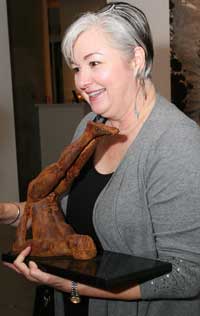
Julie McCraney-Brogdon
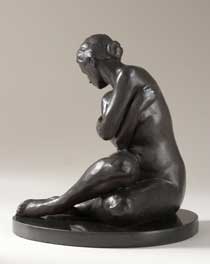
Born in Columbus, GA in 1957, Julie was immersed in art from an early age. Her mother painted, and she and Julie visited museums together. At age 11, Julie took her first art class. When she began at Mercer University, she planned to be a special education major, but an introductory sculpture class with Marshall Daugherty changed her life. He ignited the spark within her and she received a BA in Art in 1979. In 1982, she continued in graduate study with Daugherty before leaving for Amsterdam for one year of self directed study in 1983-1984.
Julie’s figurative work focuses on gender in authentic form, and she considers it vital to instill emotion into each sculpture. “Telling a story through the work is paramount to me. The pieces are carefully balanced portrayals of the human figure charged with emotion.” Her sculpture fuses tradition with social, cultural and gender issues through thoughtful, deliberate detail.
Julie’s work has been shown in exhibitions at the Kougeas Gallery in Boston; Fernbank Museum and Richards & Westbrook Galleries at Georgia Tech, and the Jacqueline Casey Hudgens Center for the Arts in Duluth, GA. At the National Arts Club and Carnegie Hall, she received the “Best of Show” award at the International Exhibition at Carnegie Hall in 1977. Julie’s sculpture in the public realm includes, among many, Emory Green, Bibb County Court House; Charles Douglass, Douglass Theatre, Macon GA; and the 7’ tall standing portrait of Peyton Anderson, Community Services Center, Macon, GA.
An elected member of both the National Association of Woman Artists and the New England Sculptors Association, Julie is also a Colleague member of the National Sculpture Society. Julie is a member of the International Sculpture Center, Washington, DC, the National Museum of Women in the Arts, Washington, DC and the GA Committee of the National Museum of Women in the Arts, Atlanta. From 1989 to 1993, she served on the Board of Directors of the Jacqueline Casey Hudgens Center for the Arts, Duluth, GA.
Her sculptures can be found in private and corporate collections both in the U.S. and abroad.
(Sculpture title: I am Beautiful)
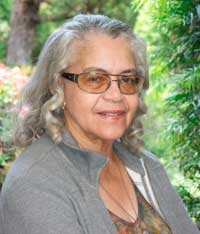
Shirley McWhorter-Moss

Artistic talent was recognized very early in Shirley Moss’ life. Her parents cultivated that talent while she was still in elementary school by enrolling her in a pilot program at the Cleveland Institute of Art that permitted children to participate in college level classes.
Four years in that program gave her a solid foundation to excel in academics as well as a broad spectrum of art disciplines. She continued her art studies at Fenn College in Cleveland, Ohio and At Ohio University while earning her Bachelor of Science in Education. Moss taught briefly in Ohio and then relocated to California, where her strong interest in mathematics led her to the aerospace industry.
After five years, she returned to education to teach mathematics and ultimately, aeronautical engineering to high school students. She attended Sacramento State University in Sacramento, California on a National Foundation scholarship in mathematics and went on to earn a Master’s in Education from United States International University in San Diego, California. When Shirley resumed her art studies, her early art training and her natural talent were quickly apparent in the detail and sensitivity of the work she produced. Her wide range of interests led her work in several mediums and styles from bronze portrait and figurative studies to investigating sculpture methods and styles of Egyptian, Pre-Columbian American art and Southwestern American Indian clay pottery.
Moss’s bronzes currently grace the homes of patrons across the United States and Canada. Her life size commissions are installed in the DuSable Museum of African American History in Chicago, Illinois; Pro Football Hall of Fame in Canton, Ohio; North Central College in Naperville, Illinois and Central Park in Naperville, Illinois; The Market at Oakland in Mt. Pleasant in South Carolina; and the Abraham Lincoln Presidential Library and Museum in Springfield, Illinois.
(Sculpture title: Theshold)
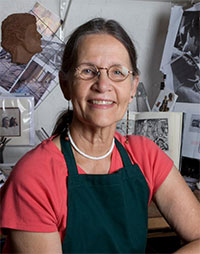
Judy Mooney
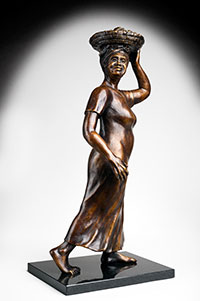
Born in Louisiana, Judy Mooney’s life and work is a rich gumbo of experiences spiced with her admiration of all people and the love of sculpting.
At the end of her career as vice president for community development with the YMCA, Judy returned to the university to study art, began sculpting and found a latent artist within herself. She also found people with stories to tell within the clay in her hands.
Today, Judy is a studio artist in Savannah, GA. She works in ceramics and bronze. Her work can be seen in shows throughout the low country, at her website, and at Lowcountry Artists in Charleston, SC, Four Corners Gallery in Bluffton, SC, and at I Pinckney Simons Gallery in Beaufort, SC.
Judy’s work is realistic figurative sculpture inspired by the people she portrays and their stories. Before touching the clay Judy researches the lives of the person she’s sculpting to ensure that it conveys an authentic message. As the figure emerges from the clay she focuses on expression and movement to capture their full essence. During the process the figure and Judy, the sculptor, begin a dialogue that defines the narrative until they agree that the piece has a voice of it’s own. Judy’s hope is that each sculpture gives new insight or joy at remembering an old familiar story or learning a new one.
(Sculpture title: The Crab Lady)
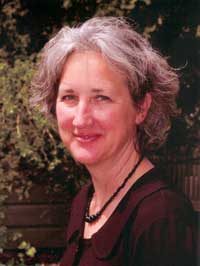
Michele Moushey Dale
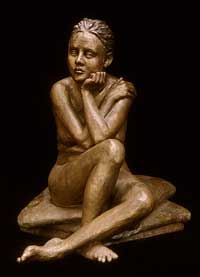
Having received a BA in Fine Art from Western Illinois University, Michele Moushey Dale also studied wood sculpture at Virginia Commonwealth University and moved to more figurative forms at the University of Wisconsin-Madison. She combines her passion for figurative forms in bronze in combination with other art mediums creating a unique synthesis of formal and emotionally expressive artistic works.
Michele seeks to portray in a simple manner the continuum of life by
focusing on a vital life source: the female body. When she begins
a piece, it’s with a vague idea, looking at line, form, flow, working
from the strength of the middle of the body and letting the sculpture
grow from there. She waits for the model to awaken an emotion which she
seeks to express in her art.
In time the body relaxes, the energy flows, the exchanges begin. The
artist and the model become friends. They laugh and live during their
time together. They are never quiet, and the unending chat brings Michele’s
pieces to what they are.
When Michele walks through her studio, she reflects on the various people who have been her models and on how their lives have touched. Michele says, “Each one of my works represents a singular aspect of the female body, so beautiful and sacred, each one distinct and different, yet sharing the same form.” Michele’s achievements include numerous regional and national exhibitions, a participating artist in the 2006 Sculpture in the Park in Loveland, Colorado, a merit award winner from Lexington Art Center, and a visiting artist at the University of Wisconsin-Whitewater.
(Sculpture title: Life As We Knew It)
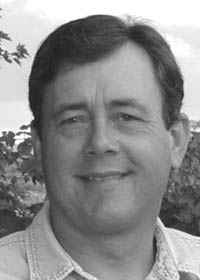
Ken Newman
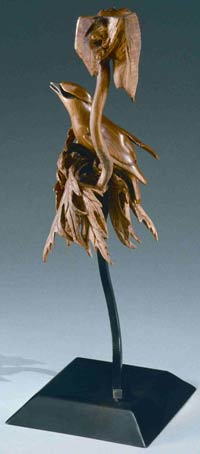
Working in the unforgiving medium of wood, wildlife sculptor Ken Newman creates sculpture that is one-of-a-kind, with no “editions” and no duplications, making each piece as unique as the animal that inspired its creation. In this raw medium, Newman sees warm grains and beautiful, flowing lines that characterize wildlife forms and movement … allowing nature to represent nature through the artist’s hand.
An admitted “wood scrounge” when young, Newman grew up along Northern California’s redwood coast, collecting unusual specimens of downed wood from beaches, riverbeds and hillsides. He now uses a variety of woods, from wind-blown cedars with cracks and imperfections to vertical-grain redwoods and water-worn driftwood.
“Working in wood is a constant challenge,” notes Newman, who confesses that the process is, at times, exasperating. “From start to finish, each piece tests the artist’s ability to work within and against the grain, knots, and wood’s imperfect nature.” But in each piece he sees a haunting beauty that he’s compelled to bring out. As each piece is carved and exposed, Ken releases a view of the tree’s life cycles, with its own unique characteristics, which many never have the opportunity to see.
Each sculpture is typically created from a single piece of wood, and the beauty of the finished wood encourages viewers to touch the sculpture, thus promoting the tactile and cognitive appreciation of all things wild.
He states, “The goal of my art is to express not just a beautiful subject, but also to help viewers understand the larger picture of the animal’s habitat and life in the wild. It is this consciousness that I want others to walk away with.”
(Sculpture title: Imprisoned Waxwing)
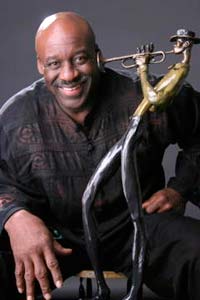
George Nock
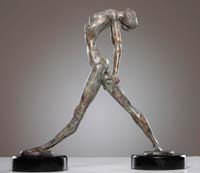
A former running back with the New York Jets and Washington Redskins, George Nock always felt he was destined to become an artist. Inspired by his junior high school teachers (one a sculptor, the other a painter) Nock sketched, sculpted and painted throughout high school – amid stellar performances on the basketball court and football field. He attended Morgan State University on a sports scholarship where he majored in psychology. By 1969, he was drafted by the New York Jets. But his love of sculpture was always with him. The team would be going over game strategy, and Nock would be working on preliminary drawings for sculptures.
After five years in the NFL, Nock retired and turned to his love of sculpture. Through hands-on practice, Nock has devoted his life to the creation of realistic figures in bronze. Self-taught, Nock has distinguished himself among the greatest sculptors of the twentieth and twenty-first century.
“I feel a responsibility to breathe life into untold stories, usually women, the culture bearers of any society.” His bronzes seem to embody a definite feeling of respect and passion regardless of subject matter. Much of Nock’s work is derived from indelible experiences stored in the crevices of his mind. Whether sculpting a figure from world history, a forgotten people, or a famed athlete, Nock possesses the uncanny ability to capture the essence of his subject with a characteristic pose or expression. Perhaps it’s his early coursework in psychology that comes into play, leaving us with the impression that his bronze works are more than mere representations – but intimate glimpses into the very core of who his figures are.
(Sculpture title: Dancer)
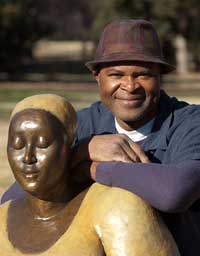
Nnamdi Okonkwo
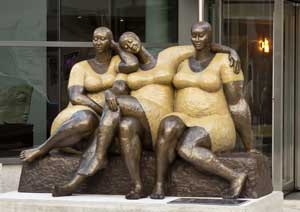
The first of three sons, Nnamdi was born in Eastern Nigeria in 1965. He was drawn to art as far back as he can remember, but didn’t realize that his artistic sensibilities were best expressed in the three-dimensional form of sculpture until he was about 17. At around the same time he was introduced to basketball, which suited him well, since he is six feet nine inches tall. Pursuing his art education in Nigeria, he obtained a Higher National Diploma (equivalent to a Bachelor’s Degree) in painting, and then discovered that it would be his talent as a basketball player that would provide the opportunity for him to come to America.
Recruited by Brigham Young University-Hawaii, he played there from 1989-1993 and graduated with a BFA in Sculpture. Immediately enrolling in the graduate program at BYU-Provo, he earned an MFA in Sculpture, and met and married his wife, Deidra.
Now working full-time out of his studio in Orem, Utah, he is drawn to the female form, and most of his work centers around womanhood. He explains, “I am captivated by the noble characteristics . . . empathy, love, resilience, inner strength . . . that are embodied in femininity. The women that are closest to me - my wife and my mother - have influenced me greatly and are exemplars of these noble attributes.”
His forms are simplified and stylized, embodying fluid lines and simple shapes, and he intends his works to be more symbolic than literal copies of the human form. Believing in the oneness of humanity, he hopes that his works will be capable of eliciting strong emotional responses from the viewer, regardless of his or her background or race. “I’ll be gratified if there is meaning in my work for all.”
Some of his outdoor sculpture can be seen in Springville City, Utah; Vacaville, California and Benson Sculpture Garden in Loveland, Colorado. Summerville welcomes him as a participant in Sculpture in the South 2004.
(Sculpture title: Friends)

Vala Ola

Vala Ola is an artist who passionately and relentlessly seeks to create artworks that show her dedication to excellence. Her classical training in Europe is reflected in her art. Her figurative bronze sculptures are noted for their depth of expression and emotion. The high quality of her sculpted form has earned her great respect among art appreciators.
"The bronze gives me an opportunity to mold the sense of life into an everlasting form. From the force of a muscle in motion to a tender human emotion expressed. That along with the abstract quality of composition is what inspires me."
Vala Ola was born and raised in Iceland, and she has lived in the United States since 1994. Vala Ola's artistic talent was apparent as a child, and from the age of thirteen she attended classes drawing models from life. After graduating from the College of Hamrahlid, she furthered her studies at the Icelandic College of the Arts, and later graduated from The Arts Institute in Bournemouth, England. She won the Icelandic Design Excellence Award for the first time at the age of twenty-six. During her studies in England, she was a finalist at the Smithsonian Young Illustrator's Competition. She was her country's sole representative at the Nordic Graphic & Illustration Awards.
Moving to the United States in 1994, she changed her focus to portraiture, and found herself booked solid for the next 7 years painting portraits in oil. Vala rekindled her interest in sculpting 2001 and has won awards from the Allied Artist’s of America, the International Guild of Realism and placed as finalist at the Art renewal Center. She is an elected professional member of the prestigious National Sculpture Society. Once a year she teaches a sculpting workshop at the Scottsdale Artist's School.
Her inspiration derives from her observation of life. Vala beleives even the most mundane circumstances we find ourselves in daily will spark an idea. The Flemish artist Vermeer would paint the simple act of pouring milk, elevating it to a moment worth remembering for eternity. In a similar way, Vala sees and captures a moment that someone else might just pass by -- as a moment worth noticing.
"All we have in life at any given time is the very moment we are living and that moment is of importance", Vala says. "I would like to inspire myself and others to have awareness and appreciation for our life."
Vala Ola sculptures in our permanent collection:
Flying (above, #23 in our brochure)
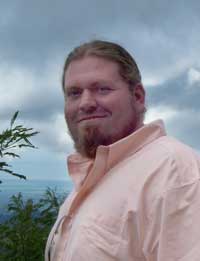
James Oleson Jr.
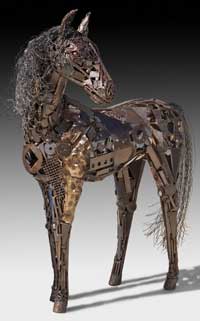
Oleson’s sculptures are created in Florida. His artwork is on display in numerous cities, and in private collections throughout the country. He is a primarily self-taught artist, and has manifested a style and technique that is unique. His direct steel approach to sculpture has gained him entry to invitational shows and museums. His list of awards and accomplishments continue to grow year after year. He is well on his way to becoming one of the world’s leading sculptors.
“The art of sculpture is to take something considered to be useless or broken and give it a new life and a chance to be a part of something bigger than it ever was. I take an inanimate congregation of objects and put them together in a way that gives them an actual presence that you can feel and touch. Not only can you touch these inanimate objects but they can touch you back. They visually speak to you, invoking real emotions. When this almost unexplainable connection is happening, the material thought to be useless or broken comes to life. That connection between you and my creations and the emotions that take place gives me much excitement and drives me to create with great passion.”
(Sculpture title: Gaze)
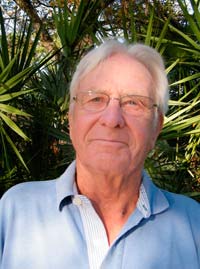
Gert E. Olsen
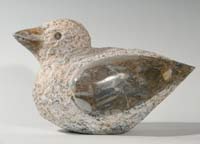
Olsen was born and educated in Denmark. He immigrated to Canada in 1956 then to the United States in 1962 where he gained citizenship. He has been a resident of Jupiter, Florida since 1984.
Olsen started his career as woodcarver which expanded into church carving. He transitioned to stone in the late 70s. He became familiar with marble by first hand observation in Pietrasanta, Italy home of the famous Cararra marble. These numerous trips to Italy resulted in importation of tons of Italian and other European marble for carving at his Jupiter studio. He also works in domestic marble and Indiana limestone.
He works with the natural texture and color of the stone to create representative sculpture of animals and human forms and to develop abstract shapes. The sculptures range from tabletop to monumental in size for indoor and outdoor display.
He has done private and corporate commissions. Olsen has shown his work all over the United States at major art shows and has had work shown in galleries in New York, Michigan, Pennsylvania, North Carolina, Virginia, Colorado, Illinois and Florida. He has work in art collections in England, Switzerland, France, Germany, Japan and his native Denmark. He has participated in Public Exhibitions in “Art “Round Town” in Saugatuck, MI and “Art in Place” in Charlottesville, VA.
(Sculpture title: Untitled)
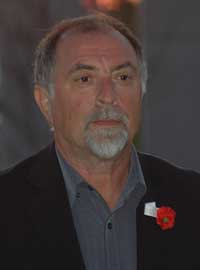
Alex Palkovich

Sculpture has always been Alex’s passion. Through
the years, he has sought to learn from his fellow artists around the
globe. Since arriving in the United States, he has studied with Tuck
Langland, Leonda Finke, Dawn Saunders, Carter Jones, and Eugene Daub,
among others. He is a member of the
Oxford Arts Society and the Royal Birmingham Society of Artists (RBSA) where
for 3 year he served as Vice President. He is also a member of the American Medallic
Sculpture Association. Alex’s work is in private and public collections
around the world and in galleries in Carmel, California, Charleston and Florence,
South Carolina, and Haifa, Israel.
In November, 2008, a monumental sculpture commissioned by a veterans’
association was unveiled. It was voted first place for Public Memorials
and Features by the American Institute of Commemorative Art in December,
2009. March, 2010, Alex installed a bust of a prominent historian in
the Florence County Library. He is working on commissions for the Performing
Art Center and the Florence County Museum. As well, he is engaged in
negotiations regarding a major historical public monument in South
Carolina.
(Sculpture title: Horse)
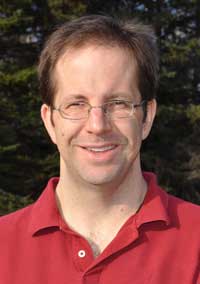
James Paulsen
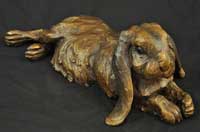
Paulsen is a self-taught artist. Alternately studying
the wilds of the northern forest, and the open beauty of the American
Southwest, he concentrates his work on natural subjects he has grown
up with, and is heavily influenced by his family's artistic background,
being raised by an artist-illustrator and an author. In his work, he
explores merging the beauty he sees in the natural world with the expressiveness
of clay and bronze.
While having most of his work in galleries or private collections across the
country, he has recently completed two public commissions, Taking Flight,
in Atlanta, Georgia, and The Defenders of Freedom Memorial in Bemidji,
Minnesota.
(Sculpture title: Lopsided)

Scott Penegar
Sculptor and painter Scott Dixson Penegar received his
art degree in 1984 from Appalachian State University. Following graduation
he moved to Morehead City, NC and worked as a commercial fisherman and
as an exhibit designer for the North Carolina Aquarium. He next moved
to Charleston, SC and became a licensed tour guide while studying marine
biology at the College of Charleston.
Scott married fellow artist Kaye and continued his art career where his main
focus was on welded sculpture and oil painting. In 1992, Scott and his wife moved
to Old San Juan, Puerto Rico where he studied with the prominent artist Jan D'Esopo.
There he worked in sculpture, painting, silkscreen and bronze casting.
Scott's art is heavily influenced by his passion for the sea. He has made two
trans-Atlantic crossings on a 34-foot sailboat, traveling from the mainland to France
and back again via the Canary Islands and the Caribbean. During his travels,
Scott spent much time visiting the works of the master painters and sculptors
that have influenced his style.
Returning to Charleston in 1995, he began working on the sculptures and paintings
that he and his wife now create at Penegar Studios. Scott's sculpture can be
found in numerous stores and catalogues, as well as private and corporate collections.
He has created sculptures for South Carolina State Parks, Brookgreen Gardens,
Ripley's Aquarium, The Frist Center for the Arts in Nashville, as well as many
private commissions. Scott also sculpted the awards for the 1997 Cooper River
Bridge Run. Along with winning many awards, he was chosen to show in the Artistic
Expressions art exhibition at the South Carolina Aquarium in 1005. He wond 2nd
place in Fine Arts at the Riverhurst Arts Festival in 1007. He shows his art
yearly at the Piccolo Spoleto Outdoor Juried Arts Festival, The Southeastern
Wildlife Exposition, and is an exhibiting member of the Charleston Artist Guild
and Tri-State Sculptors Guild.
Scott Penegar sculptures in our permanent collection:
She's A Keeper (below, #22 in our brochure)
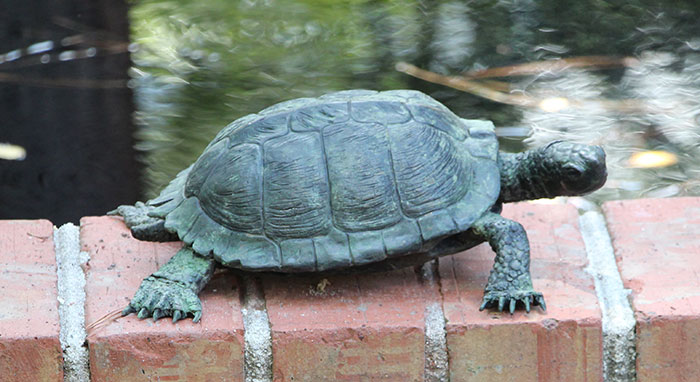
Scott Penegar sculptures in our B.I.R.D.S. collection:
Pileated Woodpecker (below, #19 in our BIRDS brochure)
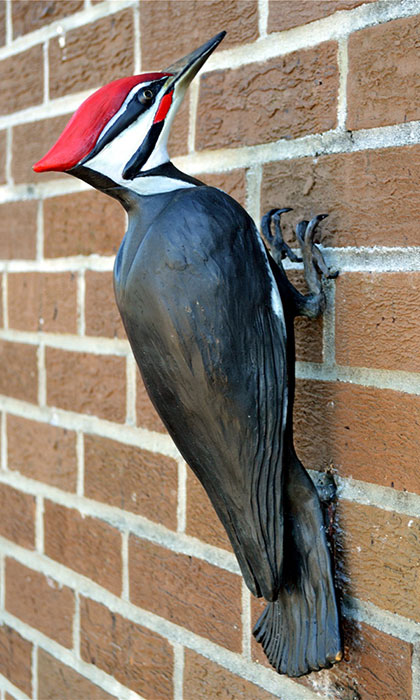
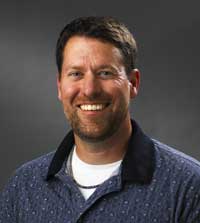
William Piller
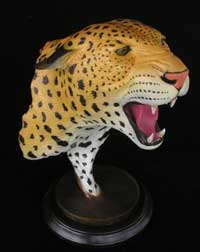
Born and raised in rural Illinois, Bill Piller spent his summers playing at his grandparents’ farm with his cousins, fishing with his family, and taking art lessons. Like most kids, he loved to paint, but didn’t discover his talent for sculpting until he was an adult. A passion for nature has helped Bill Piller to sculpt exquisite bronze treasures. Each sculpture is painstakingly researched and executed to bring out the best attributes of the subject. Only after Bill is satisfied of perfection does the clay sculpture get sent to the foundry. Using the lost wax method of casting, Bill’s sculpture is forever portrayed in all its glory in bronze.
Whether hiking mountains in Colorado to research bighorn sheep, climbing waterfalls in Alaska for a glimpse of mountain goats, trudging through Norwegian snow after grouse, snorkeling off the Maui coast with sea turtles, or scaling cliffs to get a better look at the group of over sixty majestic bald eagles congregating near open water on a frozen river, Bill invests in the effort to create a sculpture that will bring joy and inspiration for a lifetime. Bill enjoys sharing his love for and knowledge of nature with his wife and their two children.
(Sculpture title: Leopard)
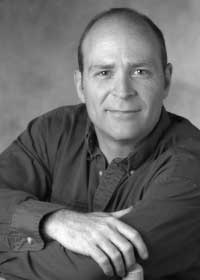
David Pollard
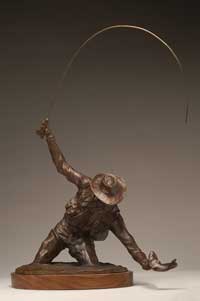
Admitting to be “a closet sculptor” since the age of 12, David Pollard has been a professional sculptor since 1996, well after he obtained Bachelors degrees in Business Administration and Management Information Systems. With an art education that has been wide and varied, David has preferred studying directly with well-known artists over the years, beginning serious study of classical figurative sculpture in Loveland, Colorado in 1992. His training has included time with such widely acclaimed artists as Smithsonian-collected sculptor Graham Weathers; Blair Buswell, official sculptor of the NFL Hall of Fame; National Sculpture Society Fellows Fritz White, Lincoln Fox and Tuck Langland; and acclaimed southwestern artist Star Liana York.
Now living in Charlotte, North Carolina, he devotes his full commitment to sculpture. He concentrates principally on gallery presentations as well as private commissions and monuments, with his works found in many private collections across the United States. David recently completed a private commission of former Olympic World Champion Disabled skier, Dan Ashbaugh, as well as the women’s reigning World 9-Ball Champion Billiards Player, Allison Fisher. David feels that sculpture is an important, lasting way of commemorating the past and reminding us of the strength and courage demonstrated by the legendary heroes that have shaped our present life in America.
An active member of the National Sculpture Society, he was one of only six sculptors to exhibit at the new Airlie Gardens Fine Art Festival in Wilmington, North Carolina, and was accepted to participate in Loveland, Colorado’s “Sculpture in the Park,” event in 2003 and has been invited to return in 2004. This is his first year participating in “Sculpture in the South.”
(Sculpture title: Rainbow)
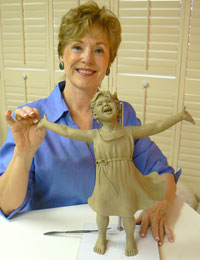
Jo Pratt
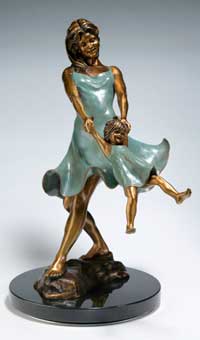
Josephine Pratt was born and raised on a farm in eastern North Carolina. Jo grew up with her love for art and dance. She pursued her love of dance by studying at the University of North Carolina at Greensboro, earning a degree in Performing Dance.
As only someone who has been trained as a dancer can sometimes do, she is able to translate the essence of a dancer’s movement and expression into sculpture that has breathtaking beauty. In her words, “My Challenge is to use the elements of composition, design, rhythm, movement and beauty to communicate emotion through my sculpture. I feel so blessed to have found that I am able to use my hands as tools to script what comes from my heart and soul. My sculpture reflects who I am.”
Jo maintains studios in Florida and North Carolina. Her sculpture can be found in galleries, private collections and churches around the country.
(Sculpture title: Untitled)

Gary Lee Price

Sculpture with meaning. Sculpture to “lift the human spirit”. Sculpture to inspire. This is the essence of Gary’s work. This is his life’s journey, to lift and to inspire!
Thousands of his sculptures are in public and private collections throughout the world. This includes his 12-foot angel “Messenger” monument in Iceland honoring over 400 early immigrants to the U.S. Gary completed the sculpture “Communion”, a 15-foot high monument of grasping hands for the United Methodist Church of Brentwood, Tennessee. The hand theme has been an important aspect of his work as reflected in such pieces as “Synergy”, “Helping Hand”, “Ascent” and “Circle of Peace”. Uplifting others, helping others and joining hands with others in brotherhood and sisterhood are essential parts of his life and work.
Gary has been commissioned to create the 300-foot Statue of Responsibility, Viktor Frankl’s vision from his book “Mans Search for Meaning”. The Monument will be the bookend to the Statue of Liberty and will be built on the west coast. This Monument and Movement is currently under way. The organizations is in the process of procuring land now.
“My passion for art and my belief that art empowers and lifts the human spirit has only grown stronger throughout my life. I have been blessed with many generous and selfless mentors, and my dream is to pass those gifts on to others”. To this end Gary often teaches workshops to individuals, groups and corporations on the aspects of creation and manifestation.
Gary, a 1981 Fine Arts graduate of the University of Utah, believes in ‘perpetual student-hood’. He finds travel and research an important part of his life. He has lived two years in Germany, as well as six months in Israel, Gary also spent one month touring the jungles and ruins of Mexico and Guatemala. Gary has researched in eleven different European countries including one full month in Egypt. In 1991 he was elected a member of the National Sculpture Society.
Gary resides in Arizona with his wife, Leesa Clark Price. Together, they have 9 children and 18 grandchildren.
Gary Lee Price sculptures in our permanent collection:
Boy of Peace (above, #16 in our brochure)
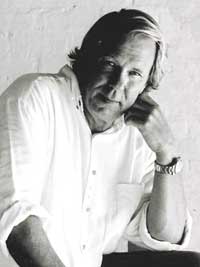
W. Stanley "Sandy" Proctor

An accomplished and internationally recognized artist
in a variety of mediums, Sandy is now most often renowned for his expertise
in figurative and wildlife sculpture. Long known for his painting and
stone carving which have been featured at museums such as the Smithsonian,
the British Museum of Natural History and the Cleveland Museum of Natural
History, he now concentrates his artistic talents mainly in bronze.
That concentration of talent has garnered him awards and commissions
across the nation, and he has installed works in locations as diverse
as the National Jewish Center Hospital in Colorado and the Polk Museum
of Art in Lakeland, Florida. His sculpture has been selected for the
permanent collection of the Leigh Yawkey Woodson Museum in Wisconsin
and has been presented to the President of the United States by the Governor
of Florida. Selected as the Featured Sculptor at Charleston's Southeastern
Wildlife Exposition, he also earned that honor at the Easton Waterfowl
Festival in Easton, Maryland.
Arguably his most memorable creation is his "Follow the Leader," which
was in Azalea Park during Sculpture in the South 2000. This life-size,
3,000-pound bronze shows children treading down a fallen log - some carefully
balancing and others "following the leader" with abandon. It's
a piece impossible to ignore, and stirs memories of yesterday (or fifty
years ago) in everyone who encounters it.
All of Sandy Proctor's works are not monuments, however. His black labs and great blue herons, little cowpokes and exquisite ballet dancers appeal to a wide audience who will relish the diversity of his subject matter.
W. Stanley Proctor sculptures in our permanent collection:
Toby (above, #2 in our brochure)

Follow the Leader (above,
#3-#8 in our brochure )
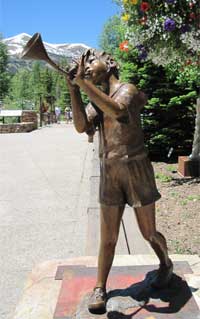
Jane Rankin
(photo of artist not available)
A native of Oklahoma, where her ancestors settled before statehood, Jane Rankin has had the good fortune to travel across the country and across the Atlantic, providing her the opportunity to view the classical sculpture of ancient Greece. Although she had dabbled in art most of her life and appreciated the three-dimensional form, her personal encounters with these ancient depictions stirred an increased interest in this art form, and solidified her resolve to make the creation of sculpture her raison d'être.
She and her family now make Monument, Colorado their home, giving her an excellent location to study with excellent sculptors at the Fechin Institute in Taos, New Mexico, the Scottsdale Artist School in Arizona, and the Loveland Academy of Fine Art in Loveland, Colorado.
She creates sculpture with which people can identify, that also can be a catalyst for reflection and the awakening of fond memories. "I believe that we need beauty in our lives for emotional and social well-being," Rankin states. "My goal is to create work with sensitivity and skill, which has beauty of workmanship, clarity of expression, and integrity of design." There are many who emphatically believe she has done just that, as her awards, public sculpture and commissions will attest.
Her works have been exhibited at Montana's C. M. Russell Museum, the Colorado History Museum, and for ten years, at the Loveland Sculpture Invitational. She's received sculpture awards in New York, Arizona and Colorado, and "Join the Parade," her sculpture of six children creating their own wonderful parade, has been selected for public installation in California, Nebraska, Colorado and North Carolina.
(Sculpture title: Girl Flute)
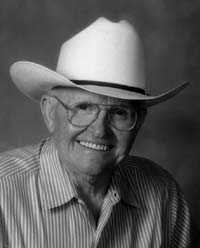
Don Ray
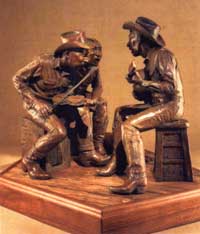
Born and raised near Clarendon, Texas, Don Ray grew up in a hard-working ranch family for whom the last possible career choice expected would be fine art. A wonderful neighbor named H.D. Bugbee, who had illustrated several books, encouraged his early artistic attempts. Between chores, he happened to meet the owner of a small printing press whose supply of good books helped develop Don's interest in Western and Southern history and culture. Art became a necessity that parental disfavor couldn't dispel.
Earning a bachelor's degree in art and a master's degree from West Texas State University, Don embarked on the "safe" route in art, illustrating for Qu arter Horse Journal and teaching for a time at West Texas State. At age 35, after a stint in the service and a progression of artistic jobs that still didn't feel like "art," he came to realize that if he didn't soon take the leap of faith into full-time art, he never would.
And so began his dedication to art, exemplifying his love of the culture of the West and South, and the beauty of the Western landscapes that he grew up experiencing. His upbringing continues to influence his subject matter, whether historical paintings or bronze sculpture.
His sculpture shown at Sculpture in the South includes "Stonewall Jackson - Soul of the South" and "Cow Camp Chorale." The extensive list of locations housing or showing his works includes the Hudson Valley Art Association in New York, The XIT Museum, Mountain Oyster Club, American Quarter Horse Heritage Center, Phippen Memorial Museum in Arizona and the Haley Library and History Center in Midland, Texas.
He was selected to create a life-size bust of Deaf Smith (Sam Houston's guide) for the hundred-year dedication of the Deaf Smith Museum, and is working on a one-and-one-half size figure of a harvester as the symbol of Pampa High School in Texas. A retrospective of his historical paintings and sculpture is on display in the Hutchinson County Museum through May, 2000.
(Sculpture title: Cowcamp)
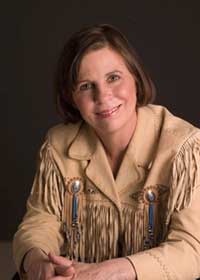
Diana Reuter-Twining
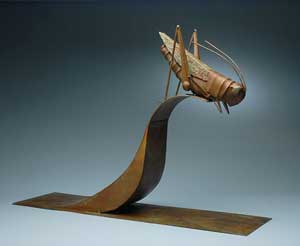
“Dynamic.” The word is an apt description of this energetic artist as well as her work. None of her animal creations are traditionally posed, but seem to be in the throes of an attack or chase, or sublimely having fun, although her languid octopus draped over a bowl does look as relaxed as any octopus you could imagine.
Several generations surrounded her as she grew up on the family farm in Virginia and gave her an appreciation of Nature and our inextricable connections with it. But it was probably a trip to East Africa in the sixties, accompanying her father on a photographic shoot for National Geographic, that awoke the artist beneath the naturalist. She apprenticed as a photographer with the magazine and later expanded her artistic breadth with a Masters in Architecture and studies in sculpture at the Corcoran School of Art, Loveland Academy of Art and the Scottsdale Artists’ School.
Her enthusiasm for her subjects is visible in her creations, with none of her works simply a study in anatomy. Life is infused in each, which has to come from personal and intimate experience with them in the wild. She and her husband, Ned, divide their time between Africa and the southern United States. Of her relationship with wildlife, she says, “I am fascinated with animals and their psychology and hope that my work helps to bring an awareness of their world, which is one we are only beginning to understand.” She is committed to the Africat Foundation, which helps preserve the habitat of the Namibian cheetah.
She has recently widened her repertoire to create figurative and imaginative works incorporating fantasy and fun, and somehow, also manages to maintain an architectural practice.
(Sculpture title: Grasshopper)
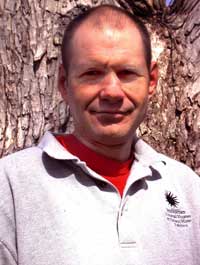
Paul Rhymer
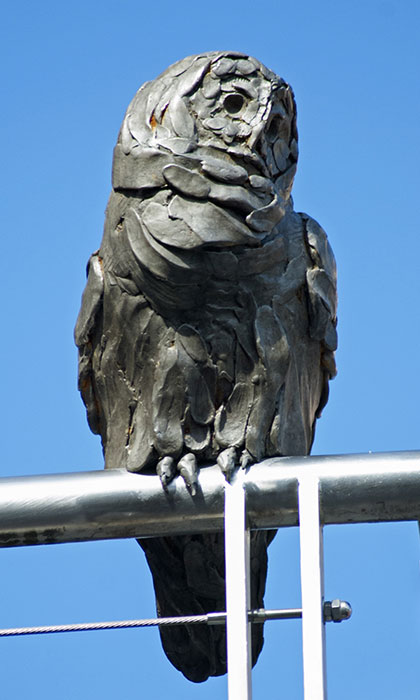
Paul Rhymer comes from a family of artists and has drawn and painted his whole life. After receiving an Associate of Arts degree from a local community college, he sought work as an illustrator, and was hired to design and illustrate brochures at the Smithsonian Institution. Eighteen years ago, Paul was offered the opportunity to become a model-maker/taxidermist at the Smithsonian, following the career path of his father, who was also a museum taxidermist.
Model-making required that Paul make a keen observation of wildlife because the exhibits that he was creating often dealt with natural history subjects. By working extensively with three-dimensional projects, Paul's painting and drawing skills gradually began to transform into sculpture. Museum taxidermy and models must be very tight and detailed, but creating sculpture gives Paul an opportunity to try different interpretations with his subjects. He says, "Some artists [are able to] capture motion or a feeling with a simple brush stroke or a simple wad of clay.” That is the perspective Paul explores in his sculpture, keeping his concentration on wildlife as his favorite subject matter.
A returning artist at the Easton, Maryland Waterfowl Festival and the Loveland, Colorado Sculpture Invitational, Paul recently completed a commissioned series of small wildlife bronzes that were installed on pathways throughout the Denver Zoo. The collection included the unique portrayal of a monitor lizard, rock hyraxes, a chameleon, an agama, and the amphibian “Dixie Pixie.” Paul’s “Rest Stop,” to be installed in Shepard Park later in 2007, will be the 19th sculpture acquisition for Summerville’s permanent collection.

Paul Rhymer sculptures in our permanent collection:
Free Ride (above, #18 in our brochure)
Paul Rhymer sculptures in our B.I.R.D.S. collection:
Barred Owl (above, #1 in our BIRDS brochure)
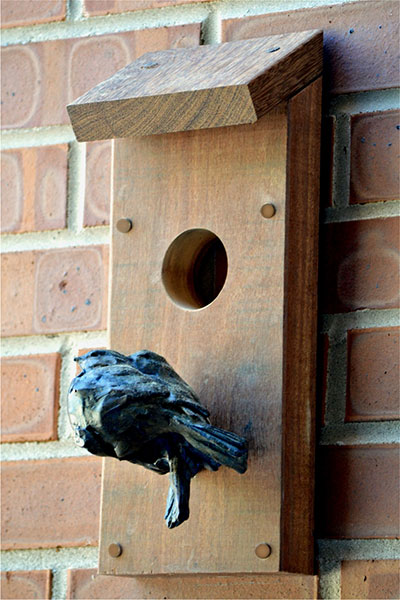
Eastern Bluebird (above, #3 in our BIRDS brochure)
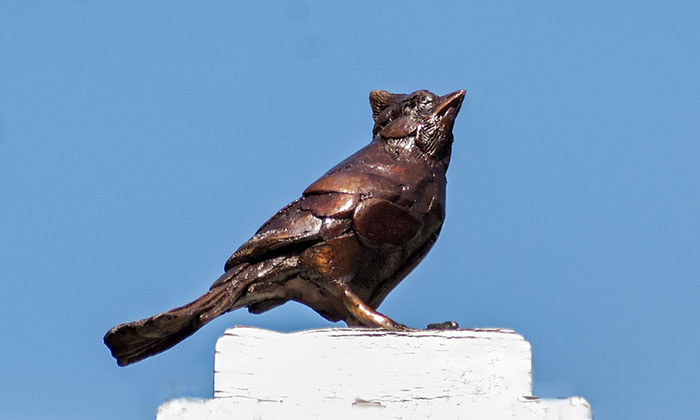
Cardinal (above, #4 in our BIRDS brochure)
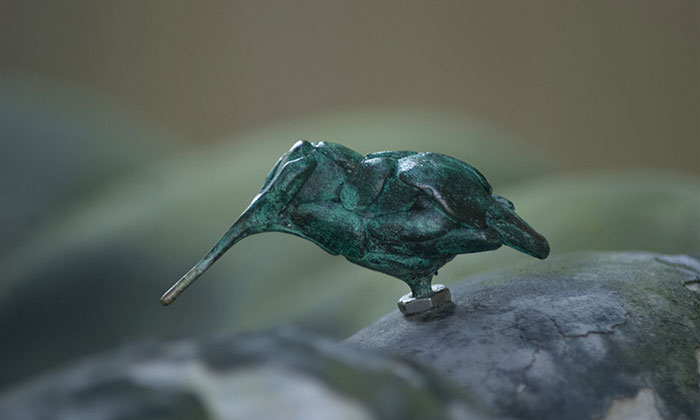
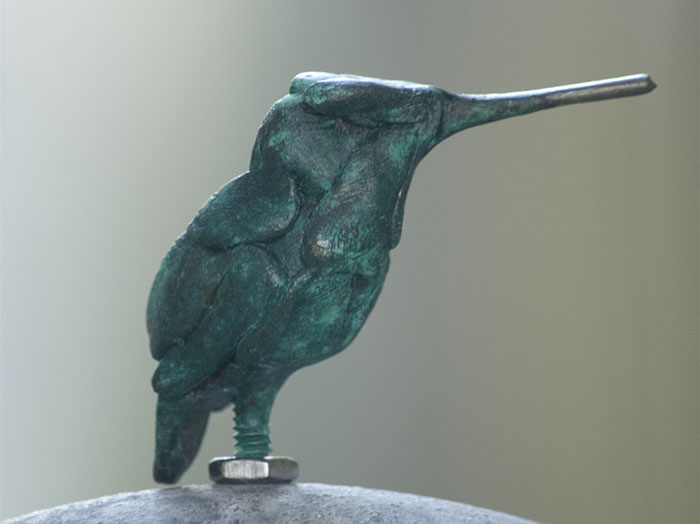
Hummingbirds (above, #6 in our BIRDS brochure)
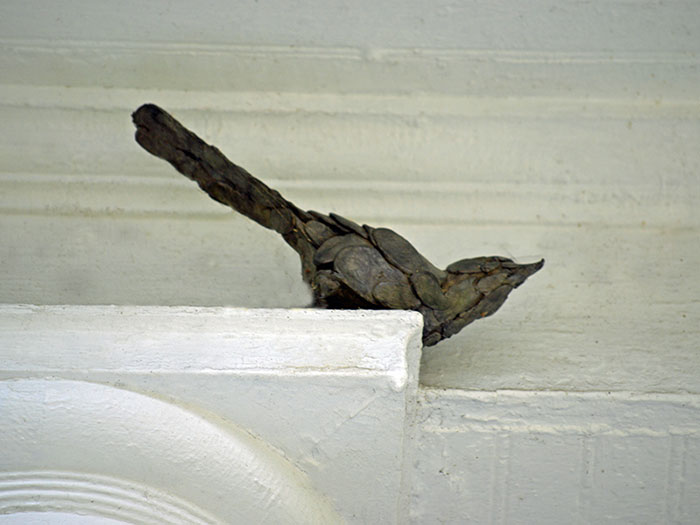
Northern Mockingbird (above, #8 in our BIRDS brochure)
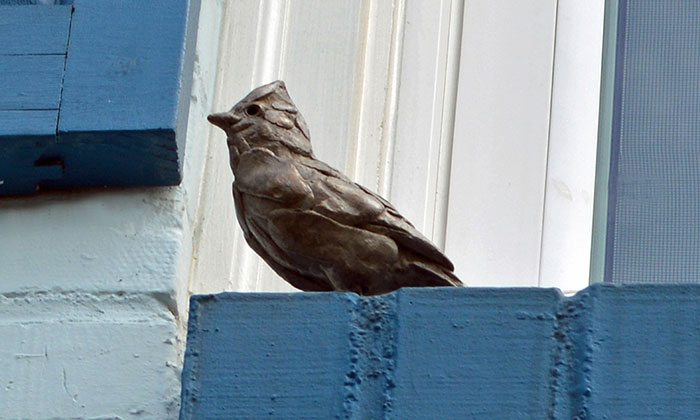
Tufted Titmouse (above, #9 in our BIRDS brochure)
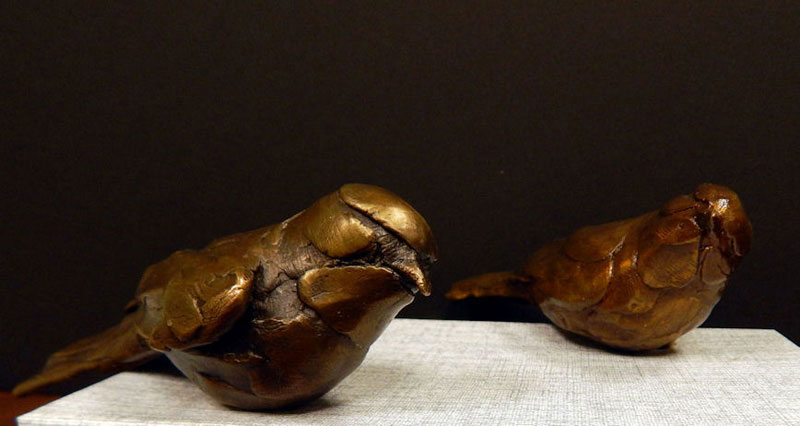
Carolina Chickadees (above, #10 in our BIRDS brochure)
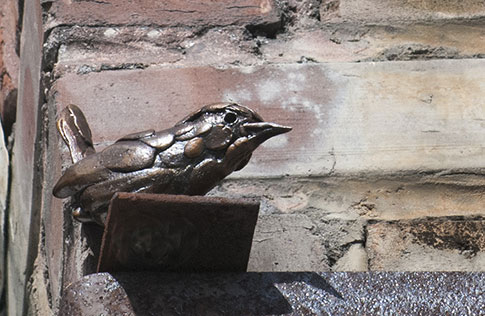
Carolina Wren (above, #12 in our BIRDS brochure)
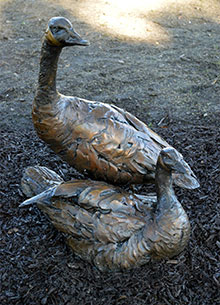
Canada Geese (above, #14 in our BIRDS brochure)
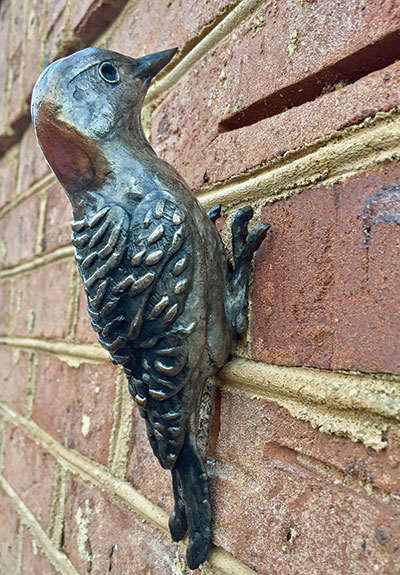
Red Bellied Woodpecker (above, #16 in our BIRDS brochure)
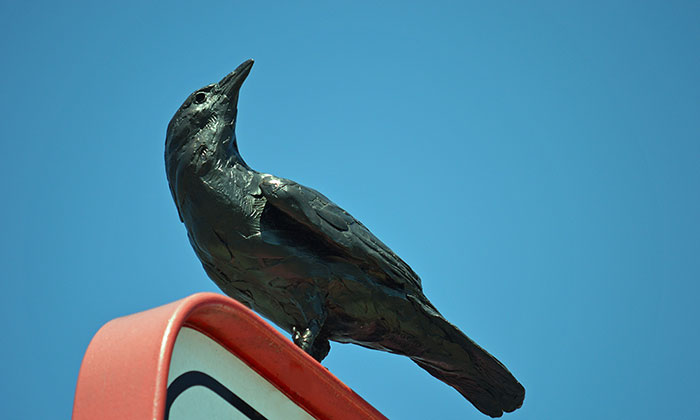
Fish Crow (above, #17 in our BIRDS brochure)
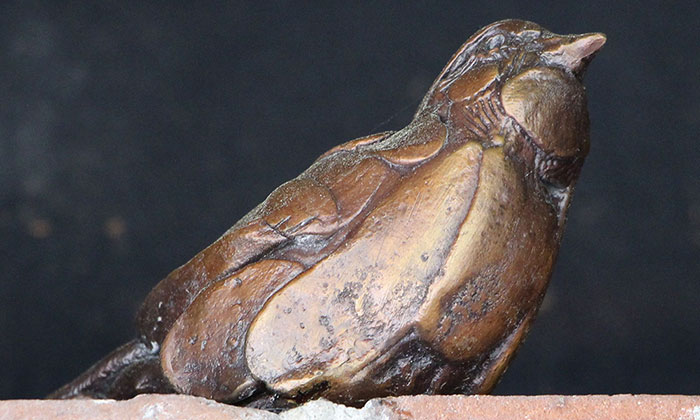
Chipping Sparrow (above, #18 in our BIRDS brochure)
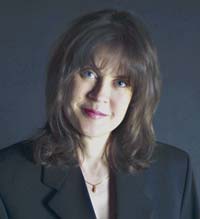
Maureen Riley
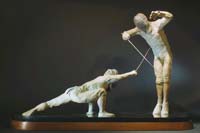
Maureen considers herself a portrait artist, human subjects or otherwise. She shamelessly admits to being an illustrator with her work narrative in nature. Her subjects all have a personality forged by events past, present and future.
Born in Michigan, Graduating from Eastern Michigan University with a BFA in Sculpture she studied under John Papas. She also studied artistic anatomy at the University of Michigan. She studied with Walter Midener, a family friend and it was in his studio as a child and later as an adult that he taught her an appreciation of sculpture as well as technique.
“In my work I strive to relay an emotion, a point in time, telling a story of events that continually occur in the world, seen but not observed. I want to stop time, to allow people to contemplate. Often life is just too transient to savor.”
Maureen is particularly taken by the words of two of her most admired artists:
My work represents my emotion in the presence of
nature
- Eugene Delacroix
The artist, on the contrary, sees; that is to say, his eye, grafted on
his heart, reads deeply into the bosom of nature.
- Auguste Rodin
(Sculpture title: untitled)
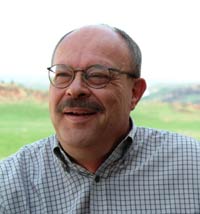
Robert Rohrbacker
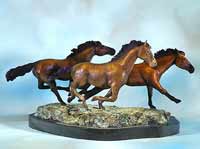
Robert Rohrbacker has spent a lifetime around animals, extensively studying and observing them in motion. As a sculptor he is mostly self-taught with an innate knowledge of proportion, musculature and bone structure. He has attended workshops with acclaimed wildlife sculptor David Turner in order to advance his natural skills. He states, “My goal is to create a sense of the grace, power and size of large creatures. I do not want to create highly stylized animals in magnificent poses, but rather capture ordinary animals doing ordinary things. My work is representational but with detail suggested by angles and curves and the interplay of light and shadow on patina and texture. I strive to create a strong sense of impending movement in my sculptures so that, in much the same way as listeners anticipate the resolution of a chord progression in music, viewers of my work complete the step, turn, twitch or flap of an ear in their minds.”
In limited participation in juried shows, Robert’s sculptures have won multiple awards, including Best of Show and People’s Choice. His subjects are usually large endangered animals, such as elephants and rhinos, but he is currently working on a complex project involving three horses.
Robert is a man of strong faith, a musician, sculptor, horseman, counselor and teacher. He and his wife live on a small acreage near Johnstown, Colorado with Betsy the dachshund, two horses, koi ponds, flower gardens and “way too many chickens.”
(Sculpture title: Almost Flying)
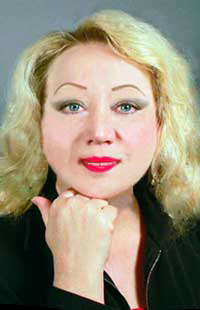
Patricia Romero

“As a sculptor, I am inspired by pure shape and form. With abstract sculpture, meaning becomes personal and individual, and I love providing that freedom for individual interpretation. For me, sculpture is both visual and tactile. I love it when people want to touch my work and I love using bright, non-traditional patinas, which makes my pieces unique. I also love adding a spiritual twist, which ads great meaning for me and I hope will speak to others, as well. The sculpting process has boundless possibilities for expression and creation and I have just begun the journey.”
Four years ago “Trish” left 25 years as a corporate trainer to pursue sculpting, her first love. She has received several awards and private commissions, and shows her work in galleries and shows throughout the country. Trish has an MA in education, but studied art at Metropolitan State College of Denver and the Art Students League of Denver.
(Sculpture title: Spirit IV)
